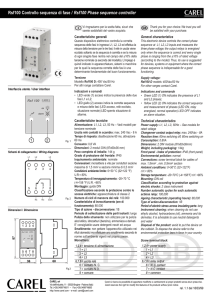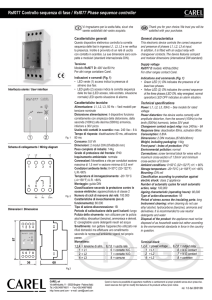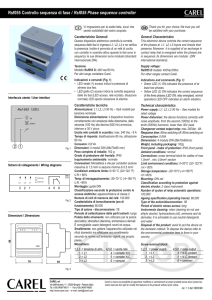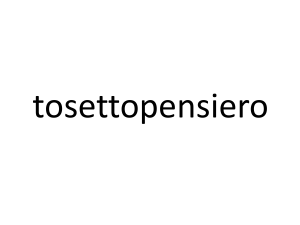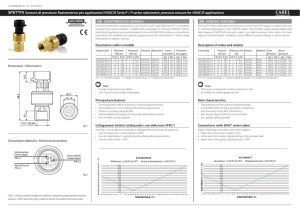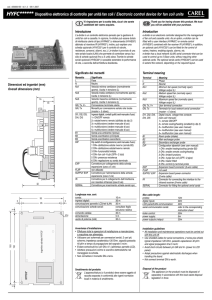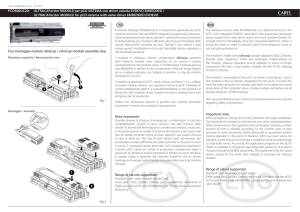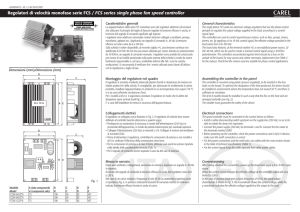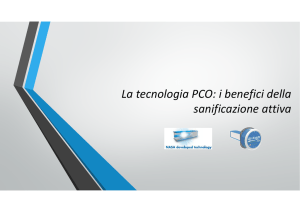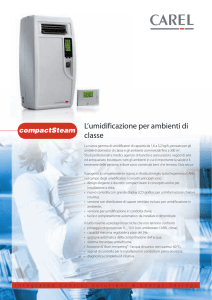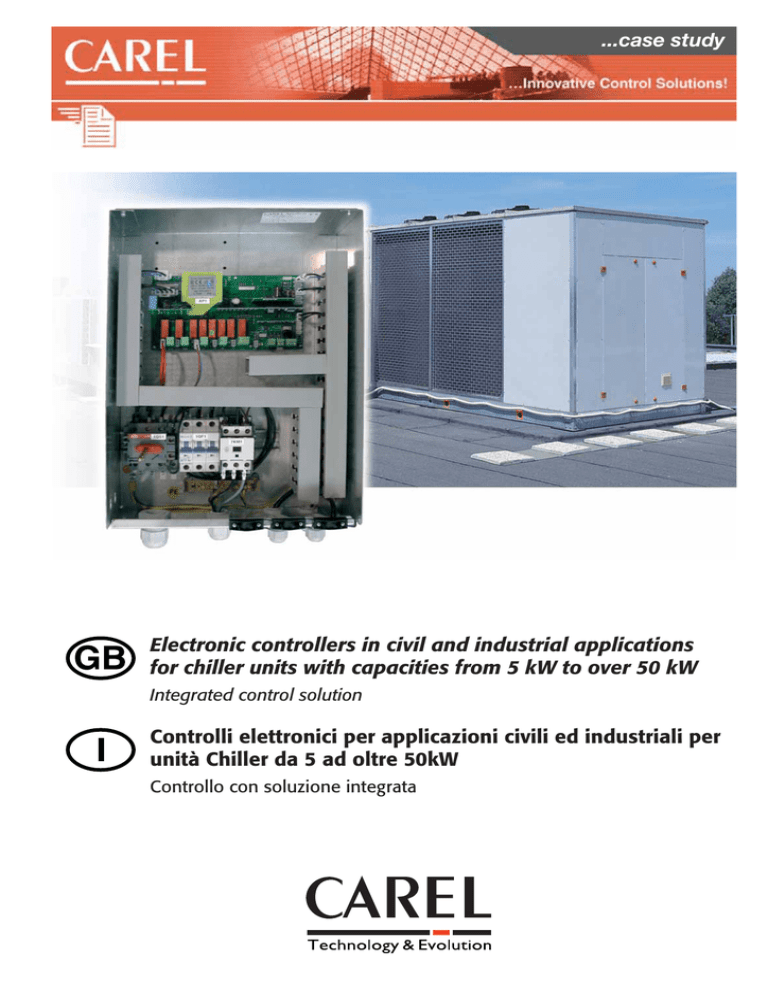
...case study
Electronic controllers in civil and industrial applications
for chiller units with capacities from 5 kW to over 50 kW
Integrated control solution
Controlli elettronici per applicazioni civili ed industriali per
unità Chiller da 5 ad oltre 50kW
Controllo con soluzione integrata
.......................................................................................................................................3
.......................................................................................................................................7
...case study
Introduction
The “CUSTOMER” is an Italian company that offers a wide range of products for the air-conditioning of civil and residential environments. It
manufactures water chillers and reverse cycle heat pumps, with capacities from 5 to over 50 kW, and a vast range of fan coils and related
accessories.
The company operates in the international markets and has its own sales and service network.
The problem
The customer requires an electrical panel with different electrical power ratings, sized for the specific units, complete with the electronic controller
for the management of the chiller units, in the following versions:
1. one circuit, two compressors;
2. two circuits, two compressors.
In both cases, it uses parametric controllers supplied by the competition, which do not allow serial connection via the network to other units, not
connection to a supervisor, and for this reason are limited to the management of the hydronic system.
In addition, the controllers do not have the features to manage all the required I/O, and therefore external electromechanical devices need to
be added (compressor thermal cutout, electromechanical protectors) inside the electrical panel. These controllers also have the inconvenience
of being parametric, and consequently are quite inflexible for hydronic applications. The user interface fitted on the unit (three displays, seven
segments with two buttons) is limited, because the different configurations of hydronic systems require the flexibility of the controller, including
remote control, so as to ensure greater energy savings.
The annual quantities are around 3000 units for the single circuit version and 1000 units for the two circuit version.
The solution
CAREL has made two programmable control boards (one per type), customised (compatible with the pCO sistema) and supplied exclusively to
the “CUSTOMER”, made using a new design concept that significantly speeds up the time to market. This solution involves the assembly of logical
functional modules on a single printed circuit board, made to the specific requirements of the customer, giving the same reliability as a standard
product (the same as the pCO sistema controllers) even for smaller production lots (PGE solution).
As for the previous supply, the solution involved the complete electrical panel. The following changes have been made to the controller:
1. the addition of a transformer;
2. built-in network filter;
3. the sizing of the terminal blocks, with a consequent reduction in the terminals block used in the electrical panel;
4. residual-current circuit breaker replaced with fuses on the board;
5. safety according to the EN60204-1 standard;
6. the addition of a further 2 relays;
7. the addition of phase rotation control, 400 Vac three-phase;
8. the addition of a temperature probe;
9. the addition of a pressure probe.
This solution has allowed the creation of a product with more features than the previous one, ensuring the following advantages for the
customer:
1. pLAN serial connection, which allows the management of an evolved hydronic system. Consequently, only one user interface needs to be
installed in the room, plus the RS485 board, or alternatively the CANbus serial board can be used together with the other boards in the
hydronic system. This allows maximum independent management by the customer in developing customised and exclusive algorithms
to specific requests;
2. possibility to use the optional pCO sistema cards. Communication, Modbus resident: LON, TREND, BACnet, RS232 modem (plus GSM to send
SMS) and TCP/IP;
3. the controller is compatible with all the pCO sistema user interface, allowing a greater differentiation of the offering;
4. addition of the min. and max. voltage control function (standard, together with phase rotation control);
5. possibility to use the EasyTools programming language, providing already developed program blocks. The customer is already familiar with
the programming system (it currently uses pCO controllers for the high end units), and consequently with the introduction of this new
controller the same programs or parts or programs can also be used for the low end units. In this specific case, for the control of two circuit
units, the software was initially developed by CAREL and then completed directly by the customer to specific requirements;
6. reduction in the mechanical dimensions of the electrical panel;
7. speed of assembly.
3
+40P200000 rel. 1.0 - 11.03.2005
...case study
The addition of new functions has brought a significant reduction to the cost the control solution, above all due to the reduction in
double components and labour costs. The customer can thus use a programmable controller for the same final cost of the electrical
panel.
The customer expressed interest and satisfaction in having been involved during the design phase in the definition and choice of the
specifications, taking active part in the selection of the components (connectors, relay, protectors) and their position, as well as regarding the
definition of the mechanical dimensions of the board.
The controller is supplied complete with:
1. a user interface with customised keypad, three digits and three buttons;
2. a 120x32 pixel graphic user interface;
3. NTC probes (quick connection);
4. pressure sensors;
5. speed controllers for the condenser fan.
Opportunities for the CAREL sales network
This document is an example of how a custom application that uses the PGE technology has been faced and resolved.
The PGE technology proposed by CAREL resolves the problem of the reliability of the products with low production volumes through the use of
standard products assembled on a customised board that is merely a support base, while guaranteeing the customer the required specifications.
Being made with standard products, the production costs can be contained, obtaining excellent quality/price advantages.
This system means we can guarantee reduced design times and a very short time to market. For the two specific cases, the development times in
each of these projects were:
1. prototypes, 1-2 units: 8 weeks from confirmation of the specifications;
2. pre-production series of 10 to 20 units: 6 weeks from confirmation of the prototypes;
3. mass production: 4 weeks, based on forecasts planned with the customer.
For other cooling control applications we can study and evaluate the best solution together with the CUSTOMER, based on the specific
requirements. The minimum quantities for custom boards are usually around a number of thousands of units per year.
As regards the electro-technical requirements, by exploiting the synergies between the companies in the CAREL group we can supply a
complete solution, including the electrical panel, 100% tested together with the controller, ensuring the advantage to the customer of
having just one supplier and thus simplifying product management and handling.
Technical specifications
Single circuit, two compressors
Single-phase power supply
Digital inputs with voltage-free contact
Digital outputs
Analogue inputs
Analogue outputs
Integrated functions
Serials
Optional boards:
Dimensions
User interface
230 Vac, -15/+10 %, 50/60 Hz
8
8
6
1
three-phase control and minimum and maximum voltage control
3
RS485 serial board;
RS232 serial board;
TREND interface;
LON interface;
clock;
120 x 220 mm
pCO sistema
4
+40P200000 rel. 1.0 - 11.03.2005
...case study
Two circuits, two compressors
Single-phase power supply
Digital inputs with voltage-free contact
Digital outputs
Analogue inputs
Analogue outputs
Integrated functions
Serials
Optional boards
Dimensions
User interface
230 Vac single-phase, -15/+10%, 50/60 Hz
12
12
9
2
three-phase control and minimum and maximum voltage control
3
RS485 serial board;
RS232 serial board;
TREND interface;
LON interface;
clock;
150 x 280 mm
pCO sistema
Electrical panels
The boards have been fitted inside the electrical panels, creating different models for different voltages and unit capacities.
Electrical panel version
V/ph/Hz
230/1/50
230/1/50
230/1/50
400/3/50
400/3/50
400/3/50
400/3/50
400/3/50
compressor power contactor
7.5 kW
11 kW
11 kW
5.5 kW
7.5 kW
11 kW
18.5 kW
22 kW
Please do not hesitate to contact me for any further information.
Sincere regards,
Germano Negri
B.U. Air Conditioning Controls
[email protected]
5
+40P200000 rel. 1.0 - 11.03.2005
...case study
Note: _____________________________________________________________
__________________________________________________________________
__________________________________________________________________
__________________________________________________________________
__________________________________________________________________
__________________________________________________________________
__________________________________________________________________
__________________________________________________________________
__________________________________________________________________
__________________________________________________________________
__________________________________________________________________
__________________________________________________________________
__________________________________________________________________
__________________________________________________________________
__________________________________________________________________
__________________________________________________________________
__________________________________________________________________
__________________________________________________________________
__________________________________________________________________
__________________________________________________________________
__________________________________________________________________
__________________________________________________________________
__________________________________________________________________
__________________________________________________________________
__________________________________________________________________
__________________________________________________________________
__________________________________________________________________
6
+40P200000 rel. 1.0 - 11.03.2005
...case study
Premessa
Il “CLIENTE” è un’azienda italiana che propone sul mercato un’ampia gamma di prodotti per la climatizzazione di ambienti civili e residenziali.
Produce refrigeratori ad acqua e pompe di calore reversibili, di potenza da 5 ad oltre 50 kW, ed una vasta gamma di prodotti fan coil e relativi
accessori.
L’azienda opera su mercati internazionali e dispone di una propria rete di distribuzione ed assistenza tecnica
Il problema
Il cliente ha la necessità di avere un quadro elettrico con diverse potenze elettriche, dimensionate per le specifiche unità con relativo controllo
elettronico per la gestione di unità chiller nelle versioni:
1. monocircuito bicompressore;
2. bicircuito bicompressore.
In entrambi i casi utilizzano controlli parametrici della concorrenza che non permettono di avere un collegamento seriale in rete verso altre unità,
o un collegamento di supervisore, e per questo sono limitati alla gestione di un sistema idronico.
Inoltre, i controlli non hanno le caratteristiche per gestire tutti gli I/O necessari, e pertanto bisogna aggiungere dispositivi elettromeccanici esterni
(termici compressore, protezioni elettromeccaniche) all’interno del quadro elettrico. Presentano inoltre l’inconveniente di essere parametrici, e
poco flessibili soprattutto per l’applicazioni idronica. Il solo terminale montato a bordo macchina (tre display, sette segmenti con due tasti) è
limitato, perché le diverse configurazioni di un sistema idronico esigono flessibilità del controllo anche da remoto, al fine di avere maggior
risparmio energetico.
Le quantità annue utilizzate sono circa 3000 pezzi per la versione monocircuito e 1000 pezzi per la versione bicircuito.
La soluzione
CAREL, ha realizzato per il “CLIENTE” due schede controllo programmabili (una per tipo), personalizzate (compatibili con il pCO sistema) e fornite
in esclusiva, utilizzando un nuovo concetto di progettazione che velocizza notevolmente il “time to market”. Si tratta di una soluzione dove sono
montati su un circuito stampato, realizzato su specifica richiesta del cliente, moduli di funzioni logiche assemblate su un’unica scheda, che
presentano la stessa affidabilità di un prodotto di serie (la stessa dei controllori del pCO sistema) anche per lotti di produzione minori (soluzione
PGE).
Come per la precedente fornitura, è richiesta la soluzione di fornitura di quadro elettrico completo. Al controllo sono state apportate le seguenti
variazioni:
1. aggiunta di un trasformatore;
2. filtro rete integrato;
3. dimensionamento delle morsettiere con conseguente riduzione dei morsetti del quadro elettrico;
4. magnetotermico differenziale sostituito con fusibili a bordo scheda;
5. sicurezza integrata secondo normativa EN60204-1;
6. aggiunta di altri 2 relè;
7. aggiunto controllo rotazione di fase 400 Vac trifase;
8. aggiunta di una sonda di temperatura;
9. aggiunta di una sonda di pressione.
Questa soluzione, ha permesso di avere un prodotto con caratteristiche superiori rispetto alla precedente, ottenendo i seguenti vantaggi per il
cliente:
1. seriale pLAN, che permette la gestione di un sistema idronico evoluto. È sufficiente quindi aggiungere solamente un terminale utente in
ambiente e la scheda RS485, oppure usare la scheda seriale CANbus insieme ad altre schede del sistema idronico. Questo permette la
massima autogestione nello sviluppare algoritmi personalizzati ed esclusivi su specifica richiesta;
2. utilizzo di schede opzioni del pCO sistema. Comunicazione, Modbus residente: LON, TREND, BACnet, modem RS232 (anche GSM per
eventuale invio SMS) e Tcp/Ip;
3. il controllo è compatibile con tutti i terminali utente del pCO sistema, proponendo una maggiore differenziazione dell’offerta;
4. si è aggiunta la funzione controllo della tensione min. e max. (di serie insieme al controllo rotazione fasi);
5. il linguaggio di programmazione EasyTools da la possibilità di utilizzare blocchi di programmi già sviluppati. Il cliente, conoscendo il sistema
di programmazione (attualmente utilizza controlli pCO in fascia high level), con l’introduzione di questo nuovo controllo può utilizzare
lo stesso o parti del programma esistente anche per la fascia “low end”. Nel caso specifico, per il controllo bicircuito, il software è stato
inizialmente sviluppato da CAREL e poi completato direttamente dal cliente su esigenze specifiche;
6. riduzione delle dimensioni meccaniche del quadro elettrico;
7. velocità di assemblaggio.
7
+40P200000 rel. 1.0 - 11.03.2005
...case study
L’integrazione di nuove funzionalità ha comportato una importante riduzione dei costi del controllo, grazie soprattutto alla riduzione dei
componenti doppi e della manodopera. Il cliente utilizza in questo modo un controllore programmabile con costo finale del complessivo
quadro elettrico invariato.
Il cliente ha manifestato interesse e soddisfazioni, nell’aver partecipato in fase di progettazione alla definizione e scelta delle specifiche,
partecipando attivamente alla scelta dei componenti (connettori, relè, protezioni) e sua posizione, e alla definizione delle dimensioni meccaniche
della scheda.
A corredo del controllo forniamo:
1. un terminale con tastiera personalizzata a tre cifre e tre tasti;
2. un terminale grafico 120x32 pixel;
3. sonde NTC (connessione rapida);
4. sensori di pressione;
5. regolatori di velocità per ventilatore di condensazione.
Opportunità per la rete vendita CAREL
Questo documento vuole essere un esempio di com’è stata affrontata e risolta un’applicazione custom che utilizza la tecnologia PGE.
La tecnologia PGE proposta da CAREL risolve il problema dell’affidabilità dei prodotti con basse quantità di produzione, utilizzando prodotti di
serie assemblati su una scheda personalizzata, che risulta essere soltanto una base di supporto, e al cliente garantisce tutte le esigenze di cui ha
bisogno. Essendo realizzata con prodotti di serie, è possibile contenere il costo produttivo, ottenendo un ottimo vantaggio in termini di
qualità/prezzo.
Grazie a questo sistema, possiamo garantire tempi di progettazione ridotti, e un “time to market” molto breve. Per i due casi specifici, il tempo di
realizzazione per ognuno di questi progetti è stato di:
1. prototipo 1-2 pezzi: 8 settimane da conferma specifiche;
2. preserie di 10…20 pezzi: 6 settimane da conferma prototipi;
3. serie: 4 settimane sulla base di un previsionale programmato con il cliente.
Per altre applicazioni legate al controllo del freddo, siamo disponibili a studiare e valutare insieme al CLIENTE, la soluzione migliore in base
all’esigenza specifica. Le quantità minime per le schede custom sono dell’ordine di qualche migliaia di pezzi l’anno.
Per quanto riguarda la parte elettrotecnica, sfruttando le sinergie tra le aziende del gruppo CAREL, siamo in grado di fornire la
soluzione completa, quadro elettrico compreso, testato e collaudato insieme al controllo al 100%, ottenendo il vantaggio per il cliente di
avere un unico fornitore e semplificando la gestione e movimentazione di magazzino.
Caratteristiche tecniche
Monocircuito bicompressore
Alimentazione monofase
Ingressi digitali contatto pulito
Uscite digitali
Ingressi analogici
Uscite analogiche taglio di fase
Funzioni built-in
Seriali
Schede opzioni per
Dimensioni
Terminali
230 Vac, -15/+10 %, 50/60 Hz
8
8
6
1
controllo trifase e controllo minima e massima tensione
3
scheda seriale RS485;
scheda seriale RS232;
interfaccia TREND;
interfaccia LON;
orologio;
120 x 220 mm
pCO sistema
8
+40P200000 rel. 1.0 - 11.03.2005
...case study
Bicircuito bicompressore
Alimentazione monofase
Ingressi digitali contatto pulito
Uscite digitali
Ingressi analogici
Uscite analogiche
Funzioni built-in
Seriali
Schede opzioni per
Dimensioni
Terminali
230 Vac monofase, -15/+10 %, 50/60 Hz
12
12
9
2
controllo trifase e controllo minima e massima tensione
3
scheda seriale RS485;
scheda seriale RS232;
interfaccia TREND;
interfaccia LON;
orologio;
150 x 280 mm
pCO sistema
Quadri elettrici
Le schede sono state inserite all’interno dei quadri elettrici, per realizzare diversi modelli differenziati per tensione e potenza.
Quadro elettrico versione
V/ph/Hz
230/1/50
230/1/50
230/1/50
400/3/50
400/3/50
400/3/50
400/3/50
400/3/50
potenza teleruttore compressore
7,5kW
11kW
11kW
5,5kW
7,5kW
11kW
18,5kW
22kW
Per ricevere ulteriori informazioni non esitate a contattarmi.
Cordiali saluti,
Germano Negri
B.U. Air Conditioning Controls
e-mail: [email protected]
9
+40P200000 rel. 1.0 - 11.03.2005
...case study
Note: _____________________________________________________________
__________________________________________________________________
__________________________________________________________________
__________________________________________________________________
__________________________________________________________________
__________________________________________________________________
__________________________________________________________________
__________________________________________________________________
__________________________________________________________________
__________________________________________________________________
__________________________________________________________________
__________________________________________________________________
__________________________________________________________________
__________________________________________________________________
__________________________________________________________________
__________________________________________________________________
__________________________________________________________________
__________________________________________________________________
__________________________________________________________________
__________________________________________________________________
__________________________________________________________________
__________________________________________________________________
__________________________________________________________________
__________________________________________________________________
__________________________________________________________________
__________________________________________________________________
__________________________________________________________________
10
+40P200000 rel. 1.0 - 11.03.2005
Divulging, modifying, translating and/or reproducing this document, in part or in full, is prohibited without the written authorisation of CAREL S.p.A.
È proibito divulgare, modificare, tradurre e/o riprodurre questo documento, in tutto o in parte, senza autorizzazione scritta di CAREL S.p.A.
CAREL S.p.A.
Via dell’Industria, 11 - 35020 Brugine - Padova (Italy)
Tel. (+39) 049.9716611 - Fax (+39) 049.9716600
e-mail: [email protected] - www.carel.com
cod. +40P200000 rel. 1.0 - 11.03.2005
Agenzia / Agency

